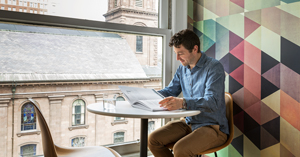How do you measure how well a workplace is performing? Start by taking a close look at your people. Does your office have the right furnishings, settings, and tools for the way people want to work?
As organizations seek to maximize employee engagement and minimize operating costs, forward-thinking architects, designers, and corporate real estate professionals are less concerned with metrics that focus on cost per square foot and square feet per person. Instead, they are looking for insight into the people who comprise the organization and how the workplace can be used as a strategic tool to support employees.
We at Herman Miller believe that workplace metrics should be given the same attention as revenue, profits, and loss. With all the changes to how, where, and why we work today, traditional benchmarks for assessing workplace effectiveness no longer apply.

The nature of work has changed, becoming more flexible and collaborative than ever before. This new way of working demands a new set of benchmarks, based on an understanding of people and their needs.
To better understand how changes in the nature of work have altered the office landscape, and to provide meaningful data about effective space allocation at the leading edge of workplace design, we are conducting ongoing research and analysis of office landscape plans gathered fr om progressive workplaces around the world.
These early findings offer insight into six emerging patterns that business leaders and their design partners can use to create, measure, and manage their own high-performing work environments. Read on for an overview of the first shift.
From Standard Conference Rooms to a Variety of Group Settings
As business leaders seek to improve organizational innovation through increased collaboration, we’re seeing a growing percentage of the office landscape allocated to group work. We’re also noting a greater variety of settings designed to support specific types of group work in response to the complexity of knowledge work today.

Through research, we’ve identified four different types of landscapes that highlight a shift in the way organizations are allocating space. The landscapes range from more traditional, with workstations and conference rooms, to more progressive, with a diverse mix of settings designed to enhance individual and collaborative work.
Analyzing the responses to a question that asked more than 100,000 employees to list the activities “important to their work,” researchers found nine distinct types of tasks relating to “collaboration/interaction.” Four of these activities— planned meetings, presentations, videoconferencing, and hosting visitors—comprise ways of working together that might be reasonably well served by a standard conference room. But the other five—collaborating on focused work, collaborating on creative work, unplanned meetings, informal social interaction, and learning from others—represent interactions that researchers called “more difficult to define” and which have “more diverse spatial needs.” Analysis showed that, for these activities, “informal work areas/breakout zones” and “a variety of different types of workspace” were “important features of an effective workplace.”

People do far more than work at a desk or meet in conference rooms throughout the day. Organizations can support a diverse range of work activities by providing a diverse range of settings fine-tuned to people’s needs. Many companies are already doing this; research indicates a shift from traditional floorplans with an average of one type of standard group space to more progressive floorplans with an average of six types of purposeful settings.
In another study, researchers observing new ways of working in two Finnish organizations also emphasized the importance of providing “different spaces for different kinds of work tasks, which enable selecting the space based on the task at hand,” and documented a need for group workspaces that include:
- Meeting rooms for formal gatherings and negotiations
- More casual places for having more creative meetings and brainstorming sessions
- Quiet rooms for tasks that require concentration and peace
- Appropriate space for informal communication and ad hoc discussion
- Appropriate social spaces such as coffee lounges
Clearly the two types of work settings—conference rooms and workstations—that continue to dominate office landscapes are no longer adequate to the task. We see an urgent need for a greater variety of settings targeted to support the unique mix of activities people pursue every day for the organization that employs them. Understanding these activities can help organizations envision workplaces that better reflect who they are and provide greater support for what they and their people do.
Discover the remaining five shifts by downloading the full white paper at HermanMiller.com
More articles from Herman Miller
Case Study: Tavistock Development Company
With Living Office, this real estate development firm created a unified workplace that’s just as vibrant as the communities it builds for clients. See how Tavistock raised its workplace effectiveness score by 25 percentage points.
Article: All Together Now
With a holistic approach to their surroundings, furnishings, and tools, these Living Office Settings offer a more natural and desirable experience of work. See how a more holistic approach to workplace planning can improve productivity for your business.
About Herman Miller
Explore our products and services for enhancing your workplace strategy, design, and management. Visit HermanMiller.com to learn more.
